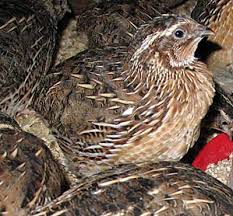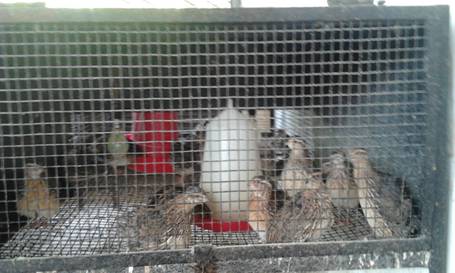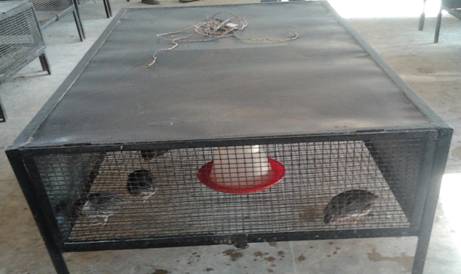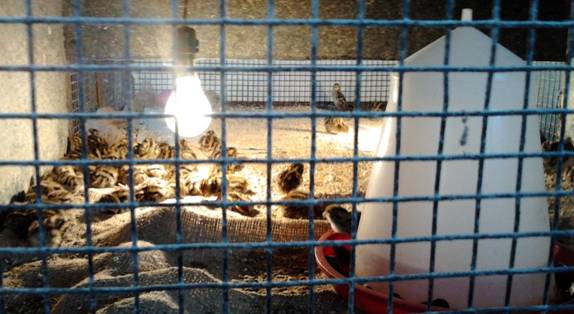
animal: Japanese quail
Scientific name : Coturnix coturnix japonica
Common / Local Name : Bater in Hindi
Quail is also popularly known as “Bater? They are hardy and easy to handle, and adopt easily to diversified agro-climatic environments. With increasing cost of production and competition among broiler and layer farmers, some alternative and equally competitive farming has become very essential for the survival of the farmers. Further, the demand for fast food has increased tremendously. In this situation, quail farming proves to be an ideal venture for the poultry farmers who desire to increase their profit through diversification.The following unique characteristics of Japanese quails make them very important over farming of other poultry species. Japanese quail weighs 8-9g from hatching egg weight of 10-11g. Average body weight at 5-6 weeks is 180-200gms and adult body weight is 200-250g. Females are heavier than males. The female is characterized by long and pointed feathers with black speckles on the throat and upper breast. The males have rusty brown throat and breast feathers. Sexually active males also have a cloacal gland, a bulbuous structure located at the upper edge of the vent which discharges a white foamy material. Very fast multiplier because of short generation interval and completes 3-4 generation per year. Prolific layer: lays 280-300 eggs per year. Early sexual maturity:6-7 weeks. Minimum floor space requirement i.e. 8-10 quails can be housed in a space required to house one broiler/layer chick. Low feed requirement: 25-30 gram per quail/day. Early marketing age for table delicacy:5-6 weeks. High nutritive value of egg and meat. Quail eggs are low in cholesterol content than chicken egg. Quail meat is low in fat and cholesterol content and is an ideal food for infants, children, adults, old people and those attempting to control their weights.
Quails can be reared either in cages or on floors or a combination of both. Thus, the options for rearing systems are option I. Brooding (0-3 weeks), rearing (4-8 weeks) and laying (8 weeks onwards) in deep litter, option II. Brooding, rearing and laying in cages and option III. Brooding in battery brooder and both rearing and laying in deep litter. Quail chicks are brooded under 24 hr light up to 2-3 weeks of age which may be reduced to 12 hr by the end of 3 weeks and thereafter 12 hr photoperiod is adequate up to 5 weeks of age. About 14-16 hr photoperiod is recommended for laying quails.
Battery brooding up to 3 weeks of age appears to be better than floor brooding due to the small size of the chick. The floor should be preferably covered with corrugated paper so as to provide better foothold since high mortality occurs initially due to spraddled legs. The feeder and water space requirement during this period are 2-3 cm and 1-1.5 cm, respectively . Floor, feeder and water spaces should be increased with advance in age. Males and females should be reared separately. Females should be housed in laying cages at about 6 weeks of age. Continuous light should be provided for the first 48 hours. This can continue if birds are to mature earlier. Otherwise 12 hr light and 12 hr darkness may be followed during the growing period. Quail broilers are marketed at about 5-6 weeks of age. Eight hrs of light and 16 hrs of darkness at least 7-10 days before marketing may help to improve the condition of quail broilers.
 Cage Rearing
Cage Rearing
 Brooding / Rearing Cages
Brooding / Rearing Cages
 Floor Rearing
Floor Rearing

Quails can be housed either on Floor or in cages. The quail house should be open type, well ventilated and well covered with wire mash on the outside wall to prevent entry of predators like snake, mongoose, cat etc. There should be provision of light and floor should be covered with litter material. Quails can be reared in multideck/singledeck cages. The size of cage should be 120 cm length , 60 cm height and 25 cm height with provision of faecal trays. For commercial purpose 20-30 quails can be reared in this cage.It is found that cage rearing of quails give better performance in terms of growth and egg out put because of less flight and less energy expenditure on other vices.
Suggested Practical Rations for Japanese Quails:
Ingrediets (Kg/100 Kg) |
Starter |
Grower |
Layer/Breeder |
|||
|
I |
II |
I |
II |
I |
II |
Ground Maize |
50.00
12.00 0.56 |
45.00
12.00 0.56 |
48.00
10.00 0.89 |
45.60
10.00 0.94 |
50.00
10.00 1.14 |
45.00
10.00 1.14 |
Average feed consumptions per bird per day
1st week -4 gm
2nd week -9 gm
3rd week -15 gm
4th week -18 gm
5th week -20-25 gm
6th week onwards- 30-35 gm
Quails are very sensitive to abrupt environmental changes, particularly during the first 2 weeks of their life. They need better care during the brooding age. Antibiotics (tetracycline @ 1g/litre ) may be used in the drinking water during first week of their life. Amprolium @ 1.25 g/ kg feed for 3 days for treatment or half of this quantity from day old to 2 weeks of age for prevention has been found to be effective to control coccidiosis in quails when they are reared deep litter. Streptomycin @ 1g/litre of drinking water can be used for 3 days to control ulcerative enteritis in quails. The hygiene and sanitation are of prime importance to eliminate or minimize the occurrence of diseases in quails. Quails are reported to be susceptible to some of the common poultry diseases but they are resistant to ranikhet disease virus and some strains of coccidia. However, they are susceptible to some strains of Eimeria i.e. E. uzura and E. tsunodai. Aspergillus fumigatus causes brooder pneumonia in quails. This can be checked by adding calcium propionate @ 2 kg/tonne of feed, since it prevents the growth of fungus.
Input availability |
Address/Contact details |
| Germplasm | Director, ICAR-CCARI, Old Goa-403 402, Goa Phone: (0832) 0832-2993097, E-mail: director.ccari@icar.gov.in |
|